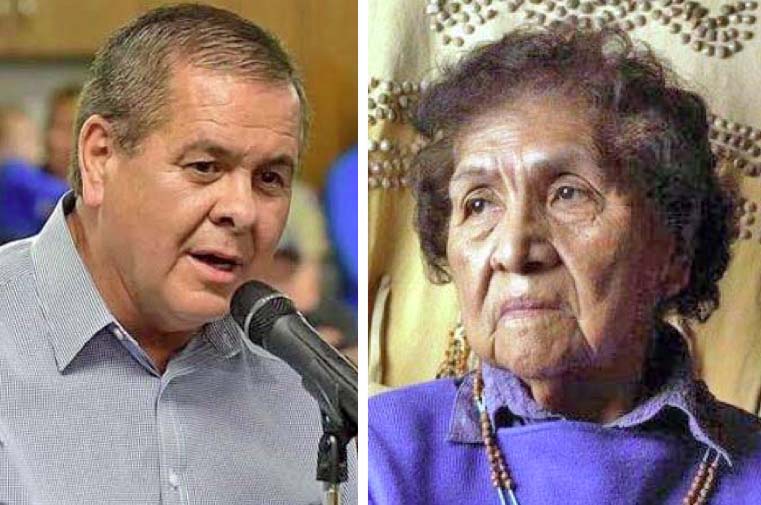Local author Darren Parry of Providence (left) credits his grandmother, Mae Timbimboo Parry (right), with inspiring him to write “Bear River Massacre: a Shoshone History.”
HYRUM – During a book-signing event sponsored by the Hyrum City Museum, local author Darren Parry expressed pride at having written a history book that doesn’t read like history.
“The other day, I had an old fellow tell me that reading my book was like sitting around a campfire sharing stories, not like a history book,” Parry told an attentive audience at the Jan. 9 event. “I was glad to hear that, because I didn’t want (Bear River Massacre: A Shoshone History) to be like a history book. I wanted it to be like the voice of my grandmother telling me stories as a child.”
Darren Parry’s grandmother was Mae Timbimboo Parry, a Shoshone oral historian and Native American activist. Her tireless efforts were largely responsible for the horrific events of Jan. 29, 1863 being appropriately reinterpreted as the Bear River Massacre.
On that date, a cavalry detachment of California Volunteers attacked a Shoshone encampment gathered where Bear River and Battle Creek meet near the current site of the city of Preston, Idaho. Hundreds of Shoshone men, women and children were killed in that practically one-sided engagement.
Darren Parry says that his grandmother’s crusade for historic accuracy took her to Washington, D.C. about 10 times, where she testified before Congress and met with U.S. presidents.
“She was one of those larger-than-life people,” he recalls. “Now, whenever historians write about (the settlement of Cache Valley), they always give her credit because they went to her as a source.
“But, to me, she was always just Grandma. She was a storyteller and I was lucky enough to sit at her feet and hear those stories as a boy.”
Darren Parry told the Hyrum audience that the transmission of oral history in the form of storytelling was an important part of traditional Shoshone culture. Much of that storytelling took place during the winter months, when bands of Shoshone would settle down to wait out the season in sheltered places like the hot springs along the Bear River.
So, Mae Timbimboo Parry was keeping that tradition alive when she entranced her grandson with Shoshone legends.
“Thank goodness that my parents both worked,” Darren Parry laughed. “I got to spend days with Grandma … and she would tell me stories about how the coyote stole fire and how the porcupine got greedy… Those were incredible stories that taught lessons about life and values … She also taught me how to bead, how to tan a deer hide, how to make moccasins, all kinds of things that a traditional Shoshone would do.”
Darren Parry freely credited Mae Timbimboo Parry with inspiring him to write Bear River Massacre: A Shoshone History.
“My grandmother always wanted to write a book,” he explained. “She spent her life writing things down. I’ve got tons of those things, including all of her journals and notes … But then she got Parkinson’s disease when she was 86, so she ran out of time and never got the chance to write her book.
“I’ve tried to pick up where she left off. It felt important for me to try to do that.”
Darren Parry’s monograph was published late in 2019, but the author spent most of the past year unsuccessfully campaigning as a Democratic candidate to represent Utah’s 1st District in Congress. So Bear River Massacre: A Shoshone History is only now receiving appropriate scholarly attention and critical review.
“Darren Parry adds an important perspective to the narrative of the American West,“ according to Michalyn Steele, a law professor at Brigham Young University. “In vivid and personal terms, he brings to life the accounts of those whose voices have too often been forgotten in telling the complex history of America and Utah.”
As a former leader of the northwestern band of the Shoshone Nation, Parry is also deeply involved in fundraising for the continuing effort to create an interpretative center on tribal land at the site of the Bear River Massacre.

